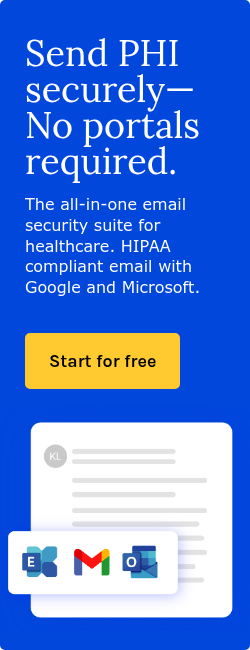2 min read
Why patient portals aren’t the right solution for HIPAA compliance
Dawn Halpin February 03, 2025

The misconception
Many healthcare organizations turn to portal-based solutions like Hushmail for HIPAA compliant email. The antiquated idea is that requiring patients to log in to read messages adds a layer of security.
But in reality, portals create more problems than they solve. They introduce unnecessary friction for both patients and providers, leading to missed messages, delayed communication, and increased IT support issues.
Read more: The risks of using patient portals for email security
Why it matters
Portals don’t necessarily improve security, but they do create frustration. Studies show that only 25-30% of patients actually log in to their portals, meaning important emails often go unread. Patients rely on timely communication from their healthcare providers, but portals add extra steps that discourage quick communication. When messages go unread, patient care suffers.
For healthcare staff, portals create additional challenges. IT teams spend unnecessary time resetting passwords and troubleshooting login issues. Employees, frustrated with extra steps, may resort to bypassing encryption altogether, putting the organization at risk of HIPAA violations.
Read more: The hidden costs of not using HIPAA compliant email
The compliance challenge
HIPAA requires that emails containing protected health information (PHI) be encrypted but does not require them to be sent through a portal. Yet many organizations assume that portals are the safest option—despite their inefficiencies.
Portals disrupt workflow by forcing both patients and providers to adapt to a new system that doesn’t integrate seamlessly with their existing tools. Patients frequently forget their login credentials, leading to missed messages and delayed responses. On the provider side, extra administrative tasks such as resending login instructions and handling access issues only add to inefficiencies.
Why your Business Associate Agreement (BAA) isn’t enough
A better way to ensure compliance
Paubox provides a frictionless alternative to patient portals. Instead of requiring logins or extra steps, Paubox automatically encrypts every email sent through Google Workspace or Microsoft 365. Patients receive messages in their inboxes like normal—no passwords, no special access codes, just secure and seamless communication.
With Paubox, healthcare organizations can:
- Eliminate patient frustration by allowing them to read emails without logging into a portal.
- Improve response times by making communication as simple as regular email.
- Reduce IT headaches since employees and patients don’t have to manage extra logins.
- Ensure HIPAA compliance with default encryption on every email, removing the risk of human error.
Read more: How HIPAA compliant email works
The Bottom Line
While patient portals may seem like a secure option for HIPAA compliance, they often cause more problems than they solve. Low engagement rates, delayed communication, and IT challenges make them an inefficient choice for encrypted email.
Paubox removes these barriers by encrypting every email automatically, allowing providers to send secure, HIPAA compliant messages without disrupting workflow. If your organization is still relying on a portal-based solution, it’s time to switch to a seamless, patient AND provider-friendly alternative that actually gets used.
Subscribe to Paubox Weekly
Every Friday we'll bring you the most important news from Paubox. Our aim is to make you smarter, faster.




